Abby’s Guide > Outdoor Power Equipment (Lawn Mowers, Snow Blowers, Chain Saws and more) > Discussions > Inside an R-Tek engine
Outdoor Power Equipment (Lawn Mowers, Snow Blowers, Chain Saws and more) Discussions |
|
jrtrebor
   
Location: Michigan - 3 hours north of Chicago on the lake
Joined: Feb 10, 2010
Points: 539
![]()
|
 |
Inside an R-Tek engine
Original Message Feb 15, 2012 6:05 pm |
|
Well I got the bolt stud welded, new old flywheel on, air gap set, good spark. Put everything else back on the engine. Still don't have the gov. vane so I just used the spring to keep the throttle at the idle position and used the idle screw to bump up the idle up a little. Put the engine back in the housing and it start on the third pull. Was idling and running well, then I heard a knock, couple seconds later heard another one then another one. So I shut it down. Was one of those sounds you know isn't good, kind of a deep sounding clank. It only made the sound maybe 3-4 times in about 20 maybe 30 seconds or run time. Pull the engine back out and decided to take it apart to check the rod cap. When I took the flywheel back off found that the new key I put in was sheared. ( could have had something to do with the knock) Was really clean inside. 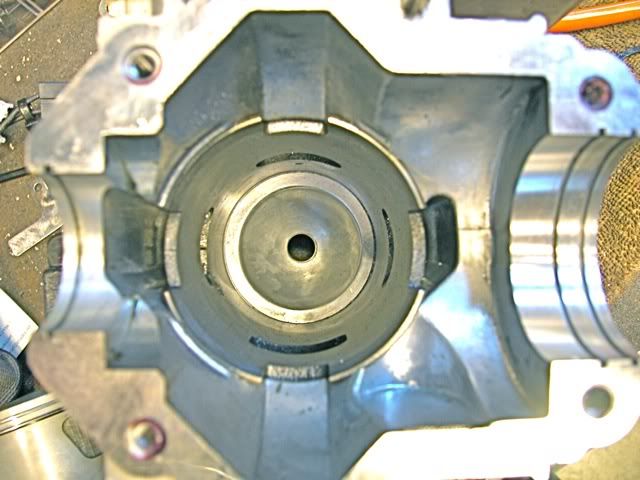 Intake port I believe 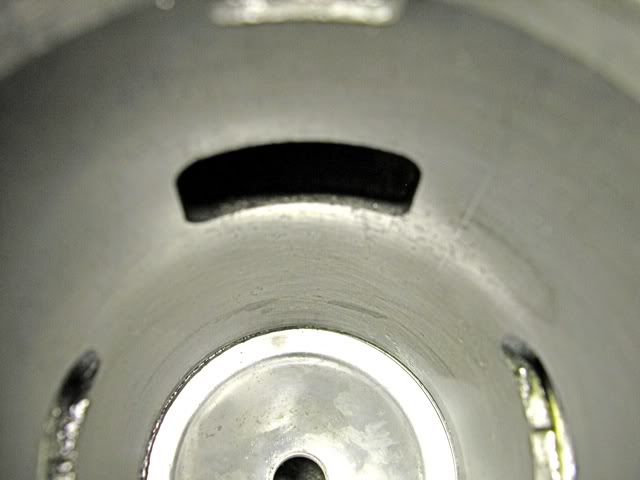 Exhaust port. The two ports on the side run down into the crankcase. Which is up in the photo. 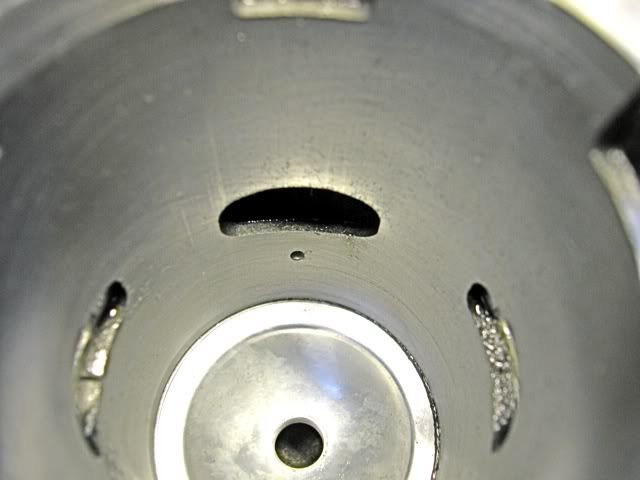 Rod end on crank. You can see the roller bearings Rod cap was tight. 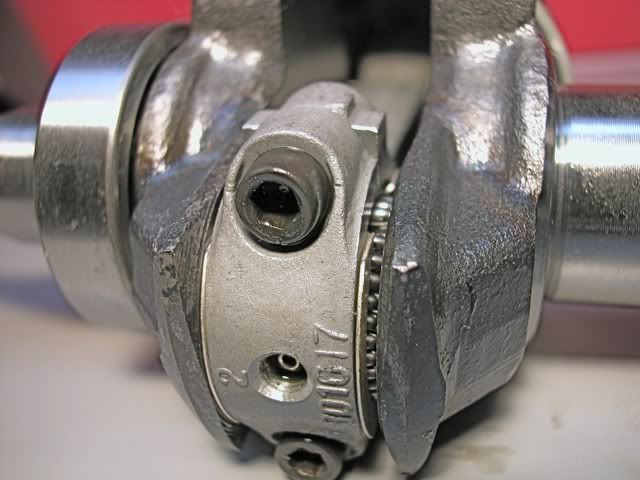 Roller bearings in the cap. Most of them stayed in place when I lifted it off. 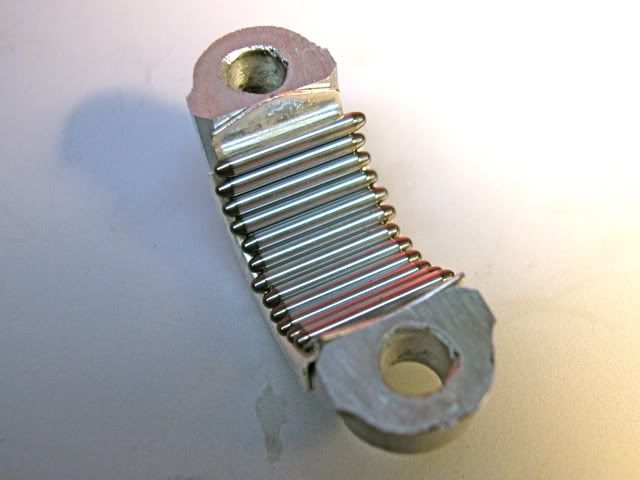 I decided to put in the old crank I had from another R-Tek. Same part numbers. I put a few drops of oil on the crank journal so the bearings would stay in place. There is enough space for one more bearing, but that's all that came out. I guess once they all get spaced that's the way it should be. 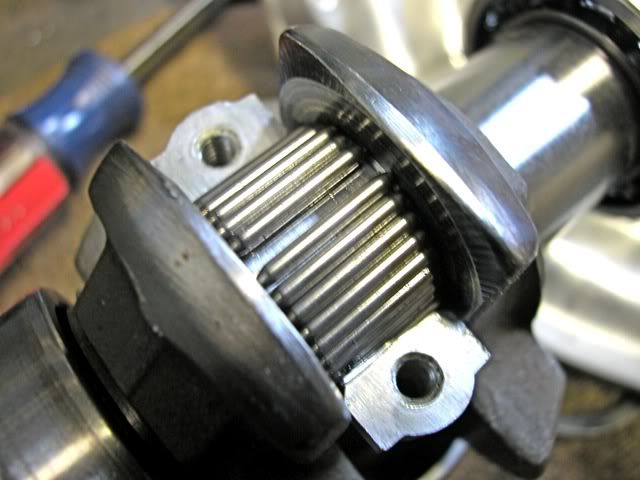 A few photos of the difference between the two cranks. Same part numbers. Top one is the older one out of a CCR2400 The ends of the counter weights are clipped off on the newer crank. (bottom photo) and the casting itself is a lot rougher. 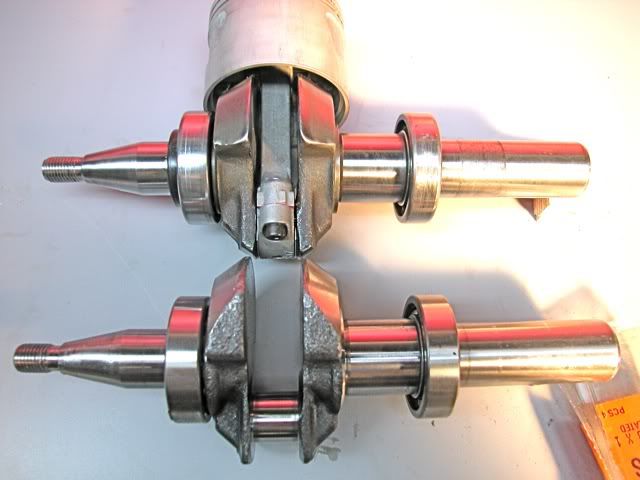 New crank on the left. If I remember to I'd like to weight them both. 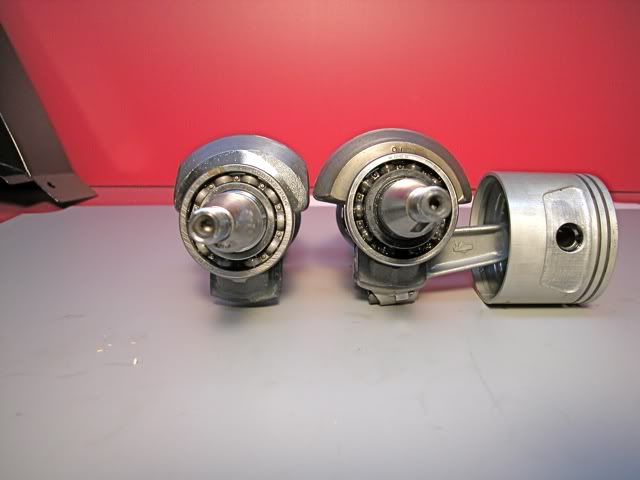 Just for comparison. Honda 11Hp crank on top. 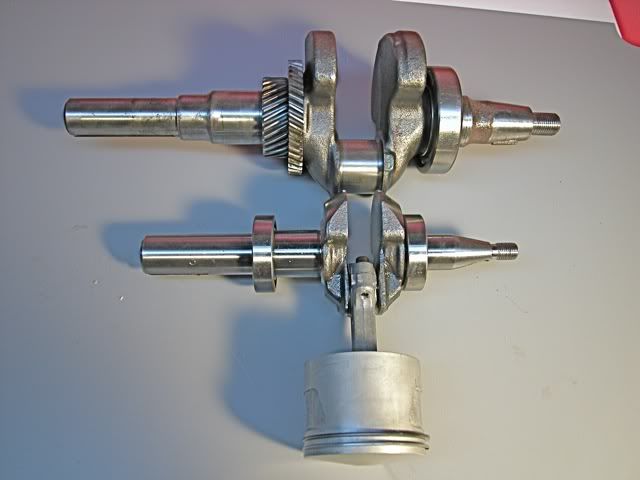 Key way slot on the replacement crank. Things were going well until I cracked a ring. Hate when that happens. There is an alignment pin in the piston ring groove for both rings. It keeps the end gap space of both of them aligned right above each other. Which normally you don't do. Unfortunately I didn't see the pins at first, pushed on the ring when it was on top of the pin not aligned in the end gap and.... snap. 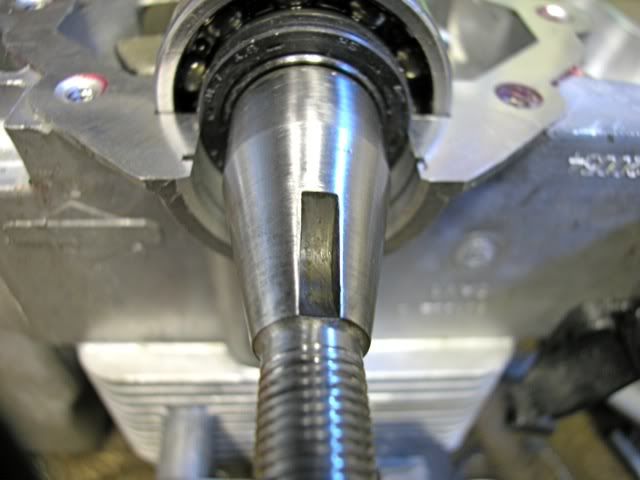
This message was modified Feb 15, 2012 by jrtrebor
|
borat
   
Joined: Nov 10, 2007
Points: 2692
![]()
|
 |
Re: Inside an R-Tek engine
Reply #1 Feb 15, 2012 7:10 pm |
|
The pin in the ring gap is to keep the rings from rotating on the piston. You have to look closely at the ring ends, the cut out on the ring is to one side with a bit of a protrusion on the other side to fit slightly under the pin. The reason for keeping the rings from rotating on the piston is so that the ring end doesn't end up catching on a port opening. Something has to be intrinsically wrong with the engine/crank to shear the key again. That's not a common occurrence. Got to wonder if the original crank might not be true. If that were the case, you'd probably see some serious vibration prior to the flywheel breaking the the shear pin. What shape are the main bearings in? I know the engine is virtually new but something somewhere is out of whack. It will be very interesting to find out what the problem was. Did you count the needle bearings? I looked up the part no. 801290 for the bearing strip but it doesn't indicate the number of needles. I looked at the image and counted 32. http://www.ereplacementparts.com/rollerstrip-p-685842.html
This message was modified Feb 15, 2012 by borat
|
jrtrebor
   
Location: Michigan - 3 hours north of Chicago on the lake
Joined: Feb 10, 2010
Points: 539
![]()
|
 |
Re: Inside an R-Tek engine
Reply #4 Feb 15, 2012 10:06 pm |
|
borat - After I saw the pins I figured they were to keep the rings from spinning and getting caught. But I was a little surprised that they were both in the same location on the piston. Lining up both the ring gaps. I would have thought that they would put them on opposite sides of the piston. The lobe does look a little tweaked. But it could be lenses distortion from being so close. I may take it by a machinist friend and have him put it on lathe and see if that shows anything. The main bearings felt and looked fine. I did not count the bearings. But will tomorrow. But I agree I think that crank just isn't right. The close up below shows better how the casting and machining was not even on the one side of the counter weight lobe. There were also strange marks on the edges of the lobes. No evidence on the piston skirt or anywhere in the crankcase of the lobes rubbing or hitting. I'm also beginning to wonder if the taper angle on the crank end is incorrect. Not allowing full contact of the flywheel hub with the crank taper surface. That would not only allow the flywheel to slip or spin on the crank. But it might also allow it to wobble. At this point I think the engine had a defective crank from the factory. Bad machining. This engine could not have been run very long. There is no carbon or heat discoloration anywhere in the engine, none, even the plug looks hardy used.
This message was modified Feb 15, 2012 by jrtrebor
|
jrtrebor
   
Location: Michigan - 3 hours north of Chicago on the lake
Joined: Feb 10, 2010
Points: 539
![]()
|
 |
Re: Inside an R-Tek engine
Reply #5 Feb 15, 2012 10:14 pm |
|
jrtrebor et al. Trust you guys are doing this as a hobby and main passion but not a primary source of income. You guys put so much love and passion to your snowblower project, it is painful to watch when you run into a problem such as this. If you can't fix it then no one can. I enjoy restoring bicycles (not the motorized kind) so I know how much fun it can be as well as a pain in the neck on an occasion. I do it as a source of additional income. But mostly because I just enjoy it. I also like the challenge of solving some of the problems. And trying to determine the causes. Building a better mouse trap is always a theme as well. Finding a better way to do something. And of course, I love tools.
|
trouts2
   
Location: Marlboro MA
Joined: Dec 8, 2007
Points: 1328
![]()
|
 |
Re: Inside an R-Tek engine
Reply #7 Feb 16, 2012 9:01 am |
|
Jrtrebor, Opened up my first two stroke a couple of months ago to get familiar with them and did snapped the ring in the same way not noticing the groove position hump.
I looked up all CCR models using the 141cc across a few years of each model run and all have drawings list the same 801220 crank. Your finding the physically different lob indicates that the drawings are not correct and for a model run there may be unaccounted for differences at lest with the online parts lists. Other than this mysterious crank it looks like Toro is getting it’s hp bumps from rpm bumps. For the HSK850 it gets a bit more fuzzy as many different makers used that engine from 4 to 7hp. There are a lot of pulley arrangements which cause crank bumps of the part numbers so hard track across engines. There is variation in the governor spring so overall it looks for Tecumseh HSK850’s the changes from 4-7hp are probably only rpm changes also with different governor springs. On the 141cc it looks like the vane and spring are the same from early 4hp 2400’s up to your 2010 6.5hp. They’re probably just spec’ing the governor spring arm to be bent for the rpm boost.
The rpm hp progression: R*Tec CCR2400 3950 4hp CCR2450 4050 4.5hp CCR3000 4150 6hp CCR3650 4250 6.5hp HSK850 CCR2400 3850 4hp CCR2500 3850 5hp SS722EC 3950 7hp (Ariens value but not a min-max like the others and probably +- 150 bringing the 7hp to possible 4200 which makes sense). In the past I thought that mufflers, carbs, possibly heads, ports, bores, pistons and rings were the cause of hp bumps. It’s looking like on the 141cc and 139cc engines over the years it’s basically adjusting the rpms for the boost.
It would be interesting to know just how much weight difference there was between your cranks. For a while I was weighting 8hp, 7hp and 5hp cranks on rebuilds. I found differences in similarly hp engines. Some differences were due to 3/4 vs 1 inch cranks but some were lob differences. The lighter cranks were in lesser maker engines (all Tecumseh) so I thought it might be do cost cutting but never sure.
|
borat
   
Joined: Nov 10, 2007
Points: 2692
![]()
|
 |
Re: Inside an R-Tek engine
Reply #8 Feb 16, 2012 9:29 am |
|
MNRunner:
I've been a motorhead all of my life. I've never charged anyone a cent for fixing something for them. I do it because, as JRT says, we enjoy the challenge of fixing something, especially at no cost to either myself or the owner. More often than not, I can. Occasionally money might be spent but judiciously.
I recall fixing a non-starting snow blower for a friend's sister. It was a very old Craftsman from the early 70's not in the greatest shape. It was the first snow storm of the year. My buddy and I drove over to the sister's house and on the way, he was explaining to me that HE had recommended a "friend of the family" mechanic to go over the snow blower for her only a month or so earlier. So I fix it in a few minutes (dirt in float bowl and auger shear pins broken). As we were driving home, he told me that he was very disappointed that we had to fix the snow blower because his sister had just shelled out ........ $480.00 for repairs!!!! I was dumbfounded. I told him the machine isn't worth $150.00, why would she pay him that much to fix it? "Friend of the family", pay the bill. That's absolute b.s. If he were a friend, he wouldn't be sticking it to the guy's sister. Would he? And, it's not like she's got tons of money being a single mom working a low paying, menial job.
It's rewarding to help people, usually friends and relatives, to save them a few bucks and often a lot of bucks. As we are all aware, 90% of stuff that doesn't work needs a very simple fix. Usually fuel related, which is often caused by negligence.
JRT:
I agree, that the ring retainer pins should be offset at least an inch or so. You'd think that having both joints in the same location would allow a bit of blow-by. Obviously hardly enough to matter. The pins on my Yamaha pistons are spread a good inch and a half apart.
It's hard to tell by looking at pictures but, that crank has to be defective. Spinning it up on a lathe should show imbalance. I'd also check it with a dial indicator to see if it's warped. I suspect that the new crank will solve the problem. Too bad about the broken ring. I hate when a $2.00 part holds up a project.
|
RedOctobyr
   
Location: Lowell area, MA
Joined: Nov 5, 2011
Points: 282
![]()
|
 |
Re: Inside an R-Tek engine
Reply #9 Feb 16, 2012 9:46 am |
|
Can you spin up a crank on a lathe to check for imbalance, though? I'd expect the crank, by itself, *should* not be balanced, since isn't it also trying to help reduce the imbalance due to the connecting rod and piston going back and forth? If the crank itself were balanced, then there's nothing to help counteract the conrod & piston. I would agree on using a dial indicator to check for runout, at least.
Now I'm curious- would you consider buying a new crank for the engine? If I could confirm that the crank is *definitely* bad, then I might consider that. But it also needs a flywheel. Barring some really cheap source for those, I will admit I, personally, might consider the engine too far gone (but I've also never had to do that kind of major surgery on an engine). Based on what I saw for Tecumseh crank pricing, a new one could be ~$70 or so, plus a flywheel, maybe at a similar price? I wouldn't pay those prices to try and resurrect it, unless I could be sure those would do it, and I could definitely sell the machine for more. But that's just me. Of course, a similar, inexpensive machine that got backed into, but still has a good engine, could be a nice source for parts.
Thus far I've primarily just fixed machines for me. Some for family. Not 'cause I'm unwilling to do it for friends, just haven't really been asked. I've fixed plenty of computers for friends & family. There is something fun about getting a device working properly again. And it's nice when it turns out to be just bad gas or something similarly straightforward.
|
jrtrebor
   
Location: Michigan - 3 hours north of Chicago on the lake
Joined: Feb 10, 2010
Points: 539
![]()
|
 |
Re: Inside an R-Tek engine
Reply #10 Feb 16, 2012 10:02 am |
|
trouts2 - I agree, Bumping up the RPM on these engines does seem to be the only difference I've been able to find that explains the increase in HP.
And as borat's video clearly showed. Higher RPM does make a difference the blowers performance. Glad to hear I'm not the only one who has made the
mistake with the ring. Bugs me when I do things like that, but sometimes that's how you learn. Trial and error. Don't mind the trials, don't like the errors.
borat - I always amazes me what some people end up paying for repairs. As you said most problems are fuel / carb. related and not a big deal.
Other issues are simple part swap fixes. I love being able to fix things for someone and feel fortunate to have the knowledge and ability to be able to do so.
Been working on all kinds of things for many years. Guess that is why I kind of enjoy trying to figuring out things like the problems with this engine.
It's a challenge, unlike a lot of other no-brainer repairs.
I just ran across an ad on CL where a guy is selling his Toro 3650 because it needs a new flywheel. Hmmmm, Maybe there is a problem Toro isn't talking
much about. Thought this was curious as well. Note: On page 32 of the R-tek engine manual, it states: " NOTE: Replace crankshaft and/or flywheel if keyway is distorted or cracked in any way."
I looked and the B&S engine manual link you posted (thank you). Read that the crank / rod needle bearing count is 33. You were close.
I know, it's usually not the cost of the part it's the delay. Although the rings are going to cost me about $20.00 unless I can find a junk engine somewhere.
Either way, it's money well spent if I can get things running correctly again, the blowers in great shape.
|
jrtrebor
   
Location: Michigan - 3 hours north of Chicago on the lake
Joined: Feb 10, 2010
Points: 539
![]()
|
 |
Re: Inside an R-Tek engine
Reply #11 Feb 16, 2012 10:25 am |
|
Now I'm curious- would you consider buying a new crank for the engine? If I could confirm that the crank is *definitely* bad, then I might consider that. But it also needs a flywheel. Barring some really cheap source for those,
Well actually I did have a crankshaft and flywheel from another R-Tek. It was in a CCR2400 that I parted out. I sold a few parts (carb, ign. coil) to get back what I had paid for the blower and make a little. Then kept the rest for spare parts. I don't do a whole lot of repairs on other people's blowers I mainly buy used blowers. Repair them for resale, or keep and upgrade / replace my personal use blowers. This 210R will be a big upgrade, it will replace my CCR2450. I'll be going from a 2001 model year blower to a 2010 model. I'll probably ask $200.00 for the 2450 but will take less (considering the lack of snow winter we've had). Only have $25.00 in the 2450 and a few hours time. I'll probably have about $65.00 total in the 210R barring any other problems. So doing the math, the 2010 Toro 210R will cost me nothing. And I'll have made $110.00 for the time I spent in both blowers.
|
borat
   
Joined: Nov 10, 2007
Points: 2692
![]()
|
 |
Re: Inside an R-Tek engine
Reply #14 Feb 16, 2012 1:44 pm |
|
"Can you spin up a crank on a lathe to check for imbalance, though? I'd expect the crank, by itself, *should* not be balanced, since isn't it also trying to help reduce the imbalance due to the connecting rod and piston going back and forth?" That makes sense. Turning the crank on the lathe to watch to see if the threaded end wobbles would be more productive. But then, so would a dial indicator. JRT: From page 23 of the manual: "If a new needle bearing set (32 needles) is being installed, the set will come on strip of paper and the needles will be coated with wax on one side. " Don't drive yourself nuts looking for no. 33.
This message was modified Feb 16, 2012 by borat
|
RedOctobyr
   
Location: Lowell area, MA
Joined: Nov 5, 2011
Points: 282
![]()
|
 |
Re: Inside an R-Tek engine
Reply #15 Feb 16, 2012 1:59 pm |
|
I have to say, it's always cool to get to see the inside of an engine that's been torn apart. I'm somewhat inspired. I have a 2-stroke weedwhacker that I'm hoping to replace with something better. It stopped running over the summer, seemed like a fuel delivery problem; I replaced the diaphragm in the carb, then it ran fine. Until the next time, and now it's tough to get running, or to keep running. It's just a cheap machine (was free to me), missing the guard, whose main redeeming quality was that it ran. Now it doesn't even have that  Really don't have the desire to spend a bunch of time to try and get it back on its feet, so perhaps I'll open the engine up instead. That would be interesting. I've never gone deeper into an engine than taking the head off (well, except for a tiny nitro-powered R/C engine which blew a conrod, and had surgery to install a new one). I'm always impressed when someone just dives deep into an engine (even better when the rest of us also get to see pics). It's one of those things I've just never had to do, so I've never tried it. |
jrtrebor
   
Location: Michigan - 3 hours north of Chicago on the lake
Joined: Feb 10, 2010
Points: 539
![]()
|
 |
Re: Inside an R-Tek engine
Reply #16 Feb 16, 2012 2:46 pm |
|
From page 23 of the manual:
"If a new needle bearing set (32 needles) is being installed, the set will come on strip of paper and the needles will be coated with wax on one side. "
Don't drive yourself nuts looking for no. 33.
Interesting, on page 30 of the "2 Cycle Engines Service and Repair Instructions". (I downloaded the PDF from the link you posted) It says "When reusing needles, coat crank pin with a thin coat of grease. Install needles (33 to a set) Fig. 13 So which is it guys 32 or 33 ? A few photos of the difference between the 1999 - CCR2400 R-Tek flywheel and the 2010 - 210R R-Tek flywheel. Same part # I guess aluminum must be expensive. Because they sure cut out a lot. 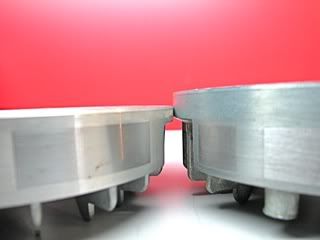 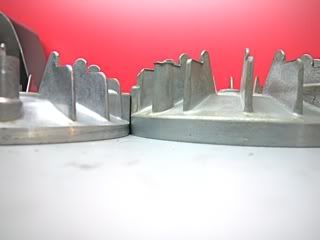 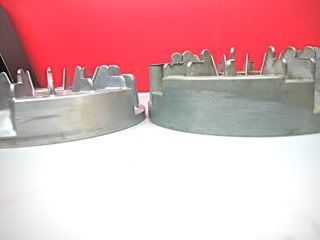 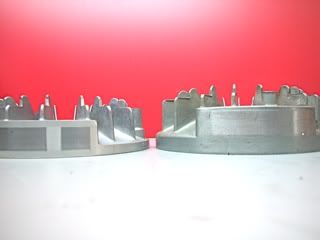 New cable routing for the tension pulley, much better. They have also replaced the lower steel cross tube with a cast aluminum piece. This Toro is much easier to work on than the earlier models. 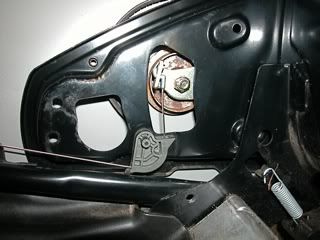 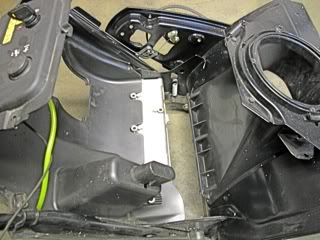 Large access hole for the carb. upper right 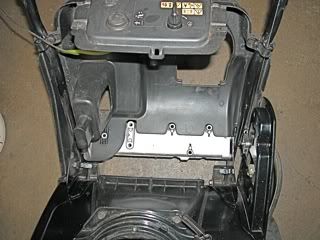
This message was modified Feb 16, 2012 by jrtrebor
|
mml4
   
Snow is good,
Deep snow is better!
Joined: Dec 31, 2003
Points: 544
![]()
|
 |
Re: Inside an R-Tek engine
Reply #24 Feb 17, 2012 7:54 am |
|
Two cycle engines cannot operate without roller/needle and ball bearings on cranks, connecting rods etc. Not enough oil in the system to run plain bearings. I think that depends on engine size. Many model airplane 2 strokes have plain bearings and they turn between twelve and 20 thousand rpm. Marc
SnapperV210P,Toro22177,TroyBilt42010Snowthrower,Craftsman Shredder,American Turbo Pressure Washer HondaGX200,Stihl011Saw,EchoPas260Trimmer Edger,EchoPB602Blower,EchoHCR150Hedge Clipper
|
borat
   
Joined: Nov 10, 2007
Points: 2692
![]()
|
 |
Re: Inside an R-Tek engine
Reply #25 Feb 17, 2012 9:05 am |
|
I think that depends on engine size. Many model airplane 2 strokes have plain bearings and they turn between twelve and 20 thousand rpm. Marc I have to say, I didn't know that about model engines. I know that any model engines my nephew owned had ball bearings for the crank. Don't recall seeing any bearing on the connecting rod/wrist pin. Understandable though. Can't imagine the tiny size of the bearings involved for those applications. I assume that the type and amount of fuel/oil flowing through a model engine might be a bit more than a regular OPE two cycle engine. If I recall correctly, a lot of unspent fuel would splatter out of the exhaust of the (very few) model engines I've seen in action. Nonetheless, there's a difference between a model airplane engine and an OPE engine. I've yet to see a plain bearing in a two cycle OPE, motorcycle. snowmobile or outboard engine.
|
RedOctobyr
   
Location: Lowell area, MA
Joined: Nov 5, 2011
Points: 282
![]()
|
 |
Re: Inside an R-Tek engine
Reply #27 Feb 18, 2012 11:22 am |
|
My little R/C nitro glowplug engines turn around 25,000-30,000 RPM, as I recall. With itty-bitty brass/bronze bushings at either end of the connecting rod. I believe there are ball bearings supporting the crankshaft at either end, at least in mine. Mine were small .12 in^3 car engines. The castor oil in the model fuel is apparently enough. As I recall, the oil percentages are higher than for mixed-gas 2-strokes. Seems like around 8%-12% or so oil is common. So there is much more oil than for 2-stroke OPE. I think most of the mess that comes out of the exhaust is the oil. You can lean up the engines for more power (and less mess, I suppose), but the temperatures will climb significantly, and it's not good for the engine. You can tell when the car is running out of gas, and starts sucking in some air bubbles, because the RPMs will just scream for the last few seconds, if you give it full throttle. trouts, I don't think the flywheel's mass would really affect HP output or rating. It would affect how quickly the engine could speed up or slow down. But in terms of steady-RPM power output (at stock speed, or a higher speed), I don't think it would make a meaningful difference. Once the flywheel is up to speed, a heavier flywheel shouldn't really sap additional power to maintain that speed. Now if one flywheel had much larger cooling vanes, let's say, that could make a difference, as it would be using more power to move the additional air around. So less of the engine's gross power output would be left to drive the rest of the machine.
This message was modified Feb 18, 2012 by RedOctobyr
|
borat
   
Joined: Nov 10, 2007
Points: 2692
![]()
|
 |
Re: Inside an R-Tek engine
Reply #28 Feb 18, 2012 12:05 pm |
|
I agree that the weight of the flywheel will not have an overall effect on horsepower but it will have effect on how the power is delivered. A good example of flywheel weight variation and effect is the difference between a motocross race bike and an enduro race bike. Motocross machines have a lighter weight flywheel to allow for much quicker throttle response to deal with the quickly changing terrain/obstacles/layout of the race course. Some tuners actually change flywheel weight to match certain types of tracks (indoor vs. outdoor). An enduro race is all outdoors and over much more varied conditions from rocks to swamps etc. Tractability outweighs throttle response in an enduro race. The heavier flywheel helps to sustain engine torque and keep power manageable. Particularly in tight twisty woods trails where breaking the back wheel loose at a bad time will put you into a tree of off the trail. Been there, done that, it hurts. On a piece of OPE, my preference would be for a heavier flywheel to sustain torque when the engine is subject to varying loads. As in a snow blower or even a lawnmower.
This message was modified Feb 18, 2012 by borat
|
jrtrebor
   
Location: Michigan - 3 hours north of Chicago on the lake
Joined: Feb 10, 2010
Points: 539
![]()
|
 |
Re: Inside an R-Tek engine
Reply #29 Feb 18, 2012 3:11 pm |
|
The newer flywheel is thinner and might have been a change for higher revs rather than metal shaving for cost. Strange as you'd think they would have bumped the part number. Would the amount of metal lessened contribute to HP via an rpm change i.e. make it a bit easier to spin. ?? The new flywheel is definitely thinner an lighter. But as others have said, having a lighter flywheel is usually about having a quicker throttle response. A lighter flywheel would be easier to spin up. But it also has less inertia. Which for a snow blower would really not be a good thing. It takes more effort / force / resistance to slow down a larger heavier moving mass than a small lighter one. Actually I don't believe the weight of the flywheel would have any effect on the max RPM. The governor is going to control that regardless of the flywheel mass is.
|
jrtrebor
   
Location: Michigan - 3 hours north of Chicago on the lake
Joined: Feb 10, 2010
Points: 539
![]()
|
 |
Re: Inside an R-Tek engine
Reply #31 Oct 15, 2012 5:36 pm |
|
JRT: Whatever happened with this project? Did you ever get the subject R-tek engine running right? Yes, I did. But we had so little snow last year I think I only got to use it once. And that was on an amount of snow that wasn't even worth talking about. Took quite a bit of time to get that one sorted out. But I think it's a pretty nice machine. It was in excellent cosmetic condition, no rust anywhere. Seems to run fine with the crank and flywheel swap. That thing had some major problems. 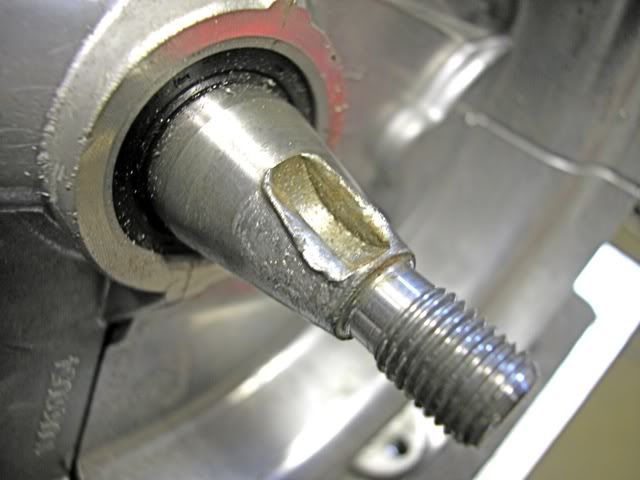  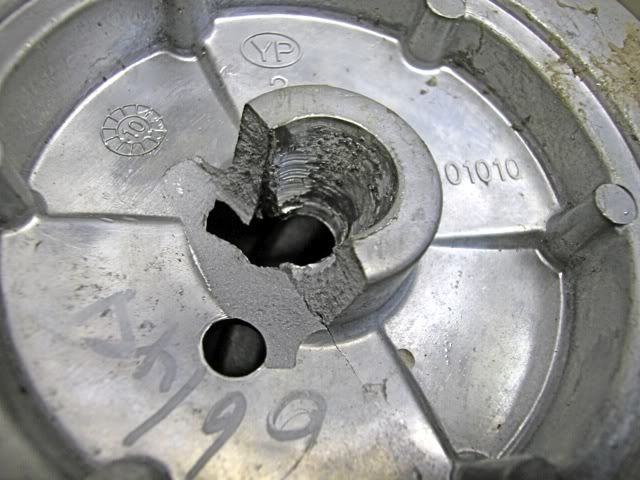
|
jrtrebor
   
Location: Michigan - 3 hours north of Chicago on the lake
Joined: Feb 10, 2010
Points: 539
![]()
|
 |
Re: Inside an R-Tek engine
Reply #33 Oct 15, 2012 8:10 pm |
|
That's some nasty stuff. So what was the underlying cause of malfunction? Bad crank? Ha,Ha good question. Kind of the chicken or the egg question.
Actually I think the flywheel may have been the initial problem.
That flywheel doesn't or didn't have a steel center hub.
Like the one I replaced it with.
I figured that the hub cracked or was cracked from over tightening.
The flywheel got a little sloppy on the shaft.
Started to maybe wobble a little, got a little more sloppy.
Which may have started to throw off the timing some.
Now it's firing at the wrong time. More stress on the crank / flywheel
joint. Then at some point things went from bad to worse real fast.
You can see how the key actually wobbled left and right in the slot.
So that flywheel hub had to be really loose on the shaft for that to happen.
That engine look so new inside and out. There wasn't even any carbon
in the muffler inlet or outlet. I think this may have been a factory assembly problem.
Or defective flywheel.
Just my somewhat educated guess.
This message was modified Oct 15, 2012 by jrtrebor
|
|
|

